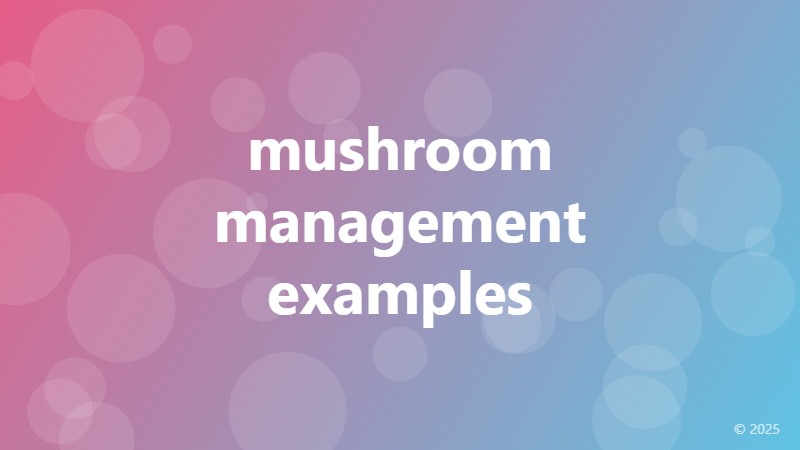mushroom management examples

Effective Mushroom Management: Examples and Strategies
Mushroom management is a crucial aspect of maintaining a healthy and productive mushroom cultivation operation. It involves implementing various strategies to optimize mushroom growth, prevent contamination, and ensure a consistent supply of high-quality mushrooms. In this article, we will explore some effective mushroom management examples and strategies that can help take your mushroom cultivation business to the next level.
Example 1: Climate Control and Temperature Management
One of the most critical factors in mushroom cultivation is maintaining a consistent and optimal temperature range. Different species of mushrooms have unique temperature requirements, and fluctuations can significantly impact growth and yield. To overcome this challenge, mushroom farmers can implement climate control systems that monitor and regulate temperature, humidity, and air circulation. For instance, a climate control system can be programmed to maintain a temperature range of 55-60°F (13-15°C) for oyster mushrooms, which is ideal for their growth.
Example 2: Substrate Management and Sterilization
The substrate used for mushroom cultivation can be a significant source of contamination. To prevent this, mushroom farmers can implement substrate management strategies such as sterilization, pasteurization, and proper handling techniques. For example, a mushroom farm can use an autoclave to sterilize the substrate, followed by a controlled cooling process to prevent overheating. This helps to eliminate any contaminants and create an optimal environment for mushroom growth.
Example 3: Pest Management and Integrated Pest Control
Pests can be a significant problem in mushroom cultivation, causing damage to crops and reducing yields. To combat this, mushroom farmers can implement integrated pest management (IPM) strategies that combine physical, cultural, biological, and chemical controls. For example, a mushroom farm can use sticky traps to monitor pest populations, introduce beneficial insects to prey on pests, and apply targeted pesticides only when necessary. This holistic approach helps to minimize the risk of pesticide resistance and maintains a healthy ecosystem.
Example 4: Water Management and Irrigation Systems
Water is a critical component of mushroom cultivation, and proper water management is essential for optimal growth. Mushroom farmers can implement efficient irrigation systems that deliver the right amount of water at the right time. For example, a drip irrigation system can be used to provide a consistent and controlled water supply, reducing evaporation and runoff. This helps to conserve water, reduce waste, and promote healthy mushroom growth.
Conclusion
Effective mushroom management is crucial for maintaining a healthy and productive mushroom cultivation operation. By implementing strategies such as climate control, substrate management, pest management, and water management, mushroom farmers can optimize mushroom growth, prevent contamination, and ensure a consistent supply of high-quality mushrooms. By adopting these examples and strategies, mushroom cultivation businesses can improve their bottom line, reduce waste, and promote sustainable agriculture practices.